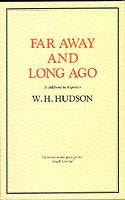We’ll get to the Great Novels another day. What I have to offer you today is a voyage to South America in the form of three favourite works of non-fiction. If you will read them in succession, and in chronological order, I think I can promise you a fascinating and remarkably affecting experience.
 |
| Galapagos finches' heads drawn by Charles Darwin |
There is a further treat in store for those who know a little about geology: Darwin’s Lyellian speculations are hilarious.
The second book is a curiosity: Far Away and Long Ago by W.H. Hudson tells the story of the author’s life from infancy to manhood among the pampas of Argentina, and later (and tragically) in its cities. Hudson was a kind of nature-mystic, though he didn’t write of his experiences in specifically spiritual terms—he just thought that was the way everyone perceived the world, that it was normal. And reading him, you can almost believe that once upon a time, out on the plains of Africa before sowing and reaping were invented, it was normal. People talk about ‘luminous prose’, but Hudson’s writing seems to describe a landscape that is itself luminous, that does not merely reflect light from the sun and moon but glows with its own. But in truth this light is also a reflection; it’s soul-light, and Hudson himself is the source. Far Away and Long Ago is no namby-pamby pastoral, though; some of the scenes are bloody, violent and terrifying, and towards the end of the book the author’s struggles to make sense of human society (of which his childhood on the pampas has taught him nothing) are heart-rending. This is a very strange book, written by a very odd man, that made its place in English literature purely on its merits and despite being unlike anything else that had ever been written. John Galsworthy described it as ‘a vision of natural beauty and of human life as it might be, quickened and sweetened by the sun and the wind and the rain, and by fellowship with all other forms of life.’ He called its author ‘a very great writer... the most valuable our age has possessed.’
 |
| Bruce Chatwin, taking a hike as usual |
Of course, it is all illusion; Chatwin was a complex and very urbane man who lived his life in compartments and enjoyed generating an air of mystery. And in fact, he seems to have had much to hide. Even his long hikes have a certain improbability about them, as he mysteriously appears on the road to so some Patagonian village or Aboriginal settlement in Australia as though beamed down from a Culture starship, walks up to the first front door he sees and knocks on it. As Paul Theroux, another great traveller, complained, ‘life was never so neat as Bruce made out.’ But that goes back to my earlier remarks about the habitual untruthfulness of fictioneers. You should never really trust us, however convincing our stories may be. In fact, the more convincing the story, the less you ought to believe it.
Taken together, these three books make up my basic literary geography of South America. It is a mystic land, but in a Spinozan kind of way its numinosity inheres in the material reality of it, its rocks and hills, its plains and forests, its plants and animals and the seasons that govern their lives. It possesses the inhabitants of the land and makes them one with it. And it is a country of the mind, not of the earth. Whether or not the real South America resembles it I have not the slightest idea, and perhaps I will never find out. But this does not really matter. Imaginary countries are the most hospitable of all.

No comments:
Post a Comment